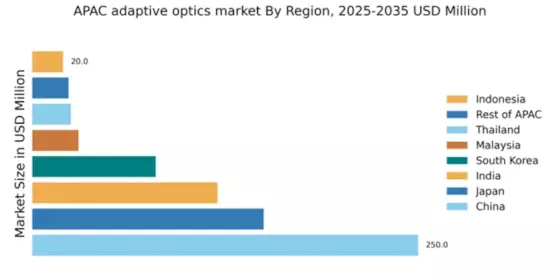Emergence of Smart City Initiatives
The emergence of smart city initiatives across APAC is driving the adaptive optics market as urban planners and governments seek to integrate advanced technologies into city infrastructure. Adaptive optics systems are being employed in various applications, including traffic management, surveillance, and public safety. By enhancing imaging capabilities, these systems contribute to more efficient urban management and improved quality of life for residents. As cities continue to evolve, the adaptive optics market in APAC is expected to grow, with estimates suggesting an increase in market value by over $300 million by 2030, fueled by smart city projects.
Growing Focus on Environmental Monitoring
The adaptive optics market in APAC is witnessing a growing focus on environmental monitoring, particularly in relation to air quality and climate change. Governments and organizations are increasingly utilizing adaptive optics technologies to improve the accuracy of atmospheric measurements. For instance, these systems can correct for atmospheric turbulence, allowing for more precise data collection from remote sensing satellites. This trend is likely to enhance the capabilities of environmental monitoring systems, potentially leading to a market growth of approximately 12% by 2030 as stakeholders prioritize sustainable development and environmental protection.
Rising Demand for High-Resolution Imaging
The adaptive optics market in APAC is experiencing a notable surge in demand for high-resolution imaging systems. This demand is primarily driven by advancements in imaging technologies across various sectors, including astronomy, defense, and biomedical applications. For instance, the integration of adaptive optics in telescopes has enhanced the clarity of astronomical observations, allowing for more detailed studies of celestial bodies. Furthermore, the healthcare sector is increasingly adopting these systems for precise imaging in surgical procedures and diagnostics. The market is projected to grow at a CAGR of approximately 15% from 2025 to 2030, indicating a robust expansion in the adaptive optics market.
Expansion of Telecommunications Infrastructure
The expansion of telecommunications infrastructure in APAC is significantly impacting the adaptive optics market. As countries in the region invest in next-generation communication networks, the need for advanced optical technologies becomes paramount. Adaptive optics systems are being integrated into fiber optic networks to enhance signal quality and reduce distortion. This integration is crucial for supporting the increasing demand for high-speed internet and data services. The adaptive optics market in APAC is anticipated to benefit from this trend, with projections indicating a market growth of around 20% by 2030, driven by the telecommunications sector.
Increased Investment in Research and Development
Investment in research and development (R&D) within the adaptive optics market in APAC is on the rise, as both public and private sectors recognize the potential of these technologies. Governments are allocating substantial funds to enhance optical systems for various applications, including telecommunications and environmental monitoring. For example, Japan has initiated several projects aimed at improving adaptive optics systems for satellite communications, which could lead to more efficient data transmission. This focus on R&D is expected to drive innovation and create new opportunities, potentially increasing the market size by over $500 million by 2030.


















Leave a Comment